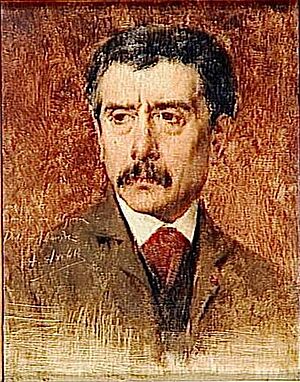Alexandre Falguière facts for kids
Alexandre Falguière (born September 7, 1831, died April 20, 1900) was a famous French artist. He was known for both his sculptures and his paintings.
Early Life and Awards
Alexandre Falguière was born in Toulouse, France. He studied art at the famous École des Beaux-Arts school in Paris. In 1859, he won the important Prix de Rome award. This award helped him study art in Rome.
He also won a special medal at the Paris Salon in 1868. The Salon was a big art show in Paris. Later, in 1878, he became an Officer of the Legion of Honour. This is a very high award in France.
Famous Sculptures
One of Falguière's first important bronze sculptures was called Le Vainqueur au Combat de Coqs. This means 'Victor of the Cockfight'. He made it in 1864. Another famous work was Tarcisius the Christian Boy-Martyr from 1867. Both of these sculptures were shown in the Luxembourg Museum. Today, you can see them in the Musée d'Orsay in Paris.
Falguière also created many large monuments. These include statues of Admiral Courbet in Abbeville and the famous Joan of Arc. Other well-known sculptures are Eve (1880) and Diana (1882 and 1891). He also made Woman and Peacock, sometimes called Juno and The Peacock.
He sculpted The Poet, which shows a poet riding Pegasus, a winged horse. He also made The Dancer, inspired by the famous dancer Cléo de Mérode. This sculpture is also in the Musée d'Orsay. In 1870, he helped create a special snow sculpture called La statue de la Résistance.
Some of his other important monuments include:
- A statue for Cardinal Lavigerie.
- The Marquis de Lafayette in Washington, D.C., USA.
- Statues of Alphonse de Lamartine (1876) and St Vincent de Paul (1879).
- A statue of the writer Honoré de Balzac. He made this after another artist's version was not accepted.
- Busts (head and shoulders sculptures) of famous people like Carolus-Duran and Ernest Alexandre Honoré Coquelin.
Paintings and Teaching
Falguière was not just a sculptor; he was also a talented painter. Some of his paintings include Wrestlers (1875) and Fan and Dagger (1882). These were once in the Luxembourg Museum. Other important paintings are The Beheading of St John the Baptist (1877) and The Sphinx (1883). He also painted Acis and Galatea (1885) and Old Woman and Child (1886).
Falguière also taught art to many students. Some of his students became famous artists themselves. These include Francis Edwin Elwell, Ernest Henri Dubois, Julien Caussé, Laurent Marqueste, Henri Crenier, and Théophile Barrau.
In 1882, Falguière became a member of the Institut de France. This is a very respected group of scholars and artists.
Alexandre Falguière passed away in Paris in 1900. He was buried in the Père Lachaise Cemetery. His student, Laurent Marqueste, created the monument at his grave.
See also
 In Spanish: Alexandre Falguière para niños
In Spanish: Alexandre Falguière para niños
- Léonce Bénédite (biographer)
- List of works by Alexandre Falguière



